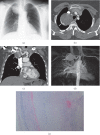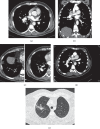Thoracic Complications in Behçet's Disease: Imaging Findings
- PMID: 32566055
- PMCID: PMC7275231
- DOI: 10.1155/2020/4649081
Thoracic Complications in Behçet's Disease: Imaging Findings
Abstract
Behçet's disease (BD) causes vascular inflammation and necrosis in a wide range of organs and tissues. In the thorax, it may cause vascular complications, affecting the aorta, brachiocephalic arteries, bronchial arteries, pulmonary arteries, pulmonary veins, capillaries, and mediastinal and thoracic inlet veins. In BD, chest radiograph is commonly used for the initial assessment of pulmonary symptoms and complications and for follow-up and establishment of the response to treatment. With the advancement of helical or multislice computed tomography (CT) technologies, such noninvasive imaging techniques have been employed for the diagnosis of vascular lesions, vascular complications, and pulmonary parenchymal manifestations of BD. CT scan (especially, CT angiography) has been used to determine the presence and severity of pulmonary complications without resorting to more invasive procedures, in conjunction with gadolinium-enhanced three-dimensional (3D) gradient-echo magnetic resonance (MR) imaging with the subtraction of arterial phase images. These radiologic methods have characteristics that are complementary to each other in diagnosis of the thoracic complications in BD. 3D ultrashort echo time (UTE) MR imaging (MRI) could potentially yield superior image quality for pulmonary vessels and lung parenchyma when compared with breath-hold 3D MR angiography.
Copyright © 2020 Kemal Ödev et al.
Conflict of interest statement
The authors of this manuscript declare no relationships with any companies whose products or services may be related to the subject matter of the article.
Figures








References
-
- Efthimiou J., Johnston C., Spiro S. G., et al. Pulmonary disease in behçet’s syndrome. QJM: An International Journal of Medicine. 1986;58:259–280. - PubMed
-
- Behçet H. Uber rezidivierende, aphthose, durchein Virus verusachte Gaschwure am Mund, am Auge und an den Genitalien. Dermatol Wochenschr. 1937;105:1152–1157.
Publication types
MeSH terms
LinkOut - more resources
Full Text Sources
Medical

